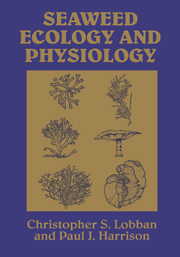Book contents
- Frontmatter
- Contents
- List of contributors
- Preface
- 1 Morphology, life histories, and morphogenesis
- 2 Seaweed communities
- 3 Biotic interactions
- 4 Light and photosynthesis
- 5 Nutrients
- 6 Temperature and salinity
- 7 Water motion
- 8 Pollution
- 9 Seaweed mariculture
- Appendix: Taxonomic classification of algae mentioned in the text
- References
- Index
9 - Seaweed mariculture
Published online by Cambridge University Press: 18 December 2009
- Frontmatter
- Contents
- List of contributors
- Preface
- 1 Morphology, life histories, and morphogenesis
- 2 Seaweed communities
- 3 Biotic interactions
- 4 Light and photosynthesis
- 5 Nutrients
- 6 Temperature and salinity
- 7 Water motion
- 8 Pollution
- 9 Seaweed mariculture
- Appendix: Taxonomic classification of algae mentioned in the text
- References
- Index
Summary
Introduction
Mariculture, or marine agronomy (Doty 1977), distinct from simple harvesting of wild stocks, is the cultivation of the sea. It involves large-scale cultivation of commercially useful organisms, including seaweeds. In Japan, China, and other Asian countries, where seaweeds have long composed an important part of the human diet, seaweed farming is a major business (Table 9.1). In other regions of the world, where the primary uses of seaweeds are as animal fodder, fertilizers, or sources of phycocolloids, wild stocks usually are harvested (Hoppe & Schmid 1969) and managed (e.g., some habitat improvement). In recent years, seaweeds have also been considered as potential solar-energy converters, to provide biomass as a source of nutrients and energy for methane-producing bacteria.
Mariculture depends on improving the conditions found in the sea, improving the plant material, or creating artificial environments, which can provide optimum conditions for growth of the plant. Thus, just as agriculture depends on vascular-plant ecology and physiology for a basic understanding of the crops, successful mariculture depends on an extensive basic knowledge of the biology and physiology of the seaweeds under cultivation and how factors important to seaweed growth can be manipulated to improve yields.
Ancient records show that people collected seaweeds for food as long ago as 2500 B.P. in China (Tseng 1981) and 1500 B.P. in Europe (Levring 1977). In the past 300 years, and particularly in the past 50 years, the practice has grown and changed, first in Japan and then in China, from the process of simply harvesting the wild stands to the processes of selecting, breeding, and cultivating certain species.
- Type
- Chapter
- Information
- Seaweed Ecology and Physiology , pp. 283 - 300Publisher: Cambridge University PressPrint publication year: 1994
- 2
- Cited by



